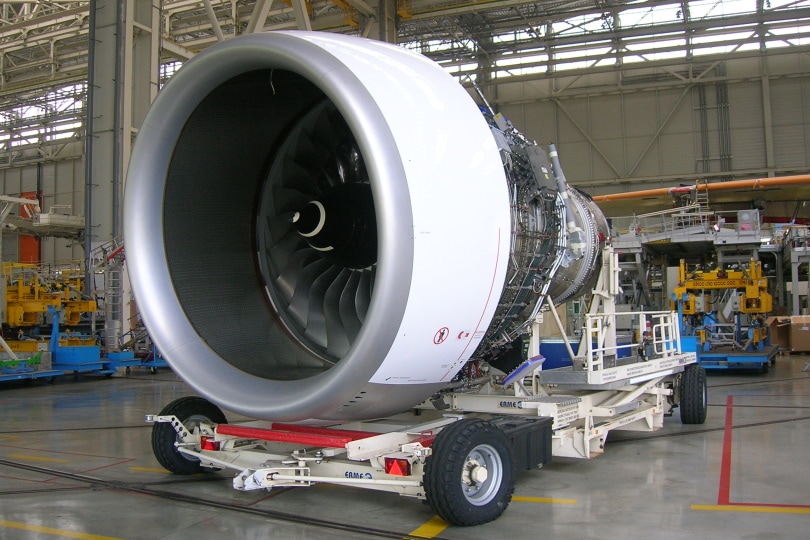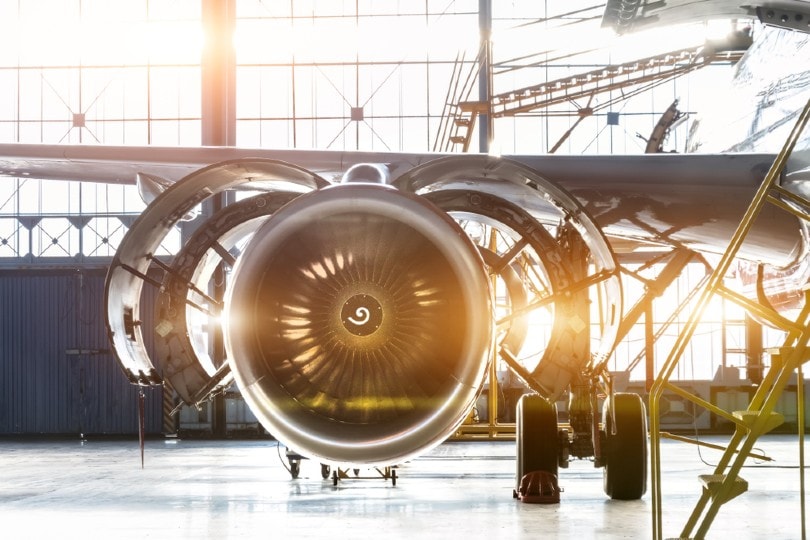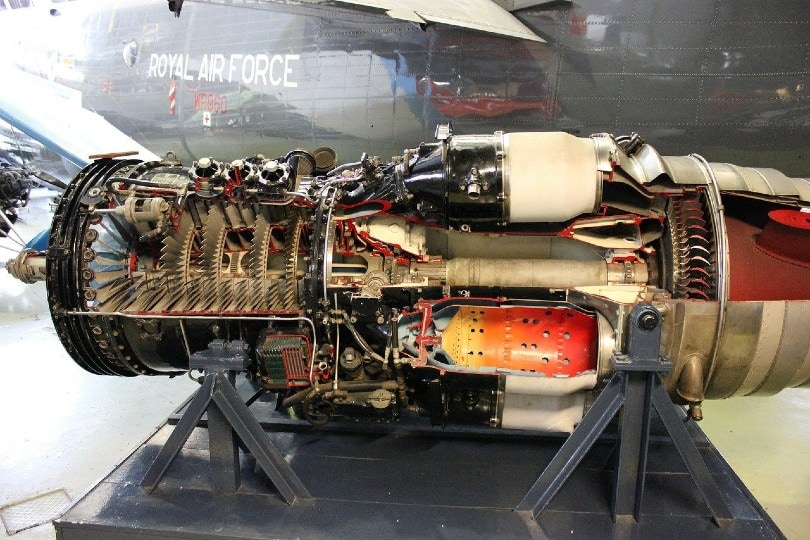How Does a Jet Engine Work? Types, Facts & FAQ
-
Pete Ortiz
- Last updated:

Flying thousands of feet in the air and weighing over 30,000 pounds, the modern commercial airplane needs a lot of help staying aloft. The continuous power to lift and keep these mammoth machines in the air is more than your average car engine can handle, so to get the required thrust, airplanes instead rely on jet engines.
Jet engines are complex bits of machinery, but when you understand the essence of how they work, you’ll find the design is pretty clever. We’ll explain the fundamentals of how jet engines work so you can have a little more perspective during your next flight.
How Does It Work?
Jet engines are gas-powered turbines that continuously pull air in through a fan in the front and expel exhaust out the back. The incoming air goes through a compression phase between the front and tail end before mixing with fuel, igniting, and propelling the plane forward.
While there are several types of jet engines, the most common type of engine is the turbofan. Commercial airliners primarily use this design. More private jets are also now utilizing them in smaller designs. The engine consists of five key components:
- Fan
- Compressor
- Combustor
- Turbine
- Exhaust
An exterior shell (the diffuser) houses the components. The fan has a greater diameter than the engine core behind it. Only a minor amount of air from the fan goes through the compressor and combustor to the exhaust. The rest of the air, called bypass air, moves around the engine’s exterior.

Turbofan engines vary in their bypass ratio, the air mass converted to bypass air versus the air mass directed into the core to power the turbine. A higher bypass ratio means more air goes to the bypass than the core.
With a higher air volume going to bypass, the engine needs less speed to generate equal amounts of thrust. That means it becomes more efficient when the bypass ratio increases.
Most turbofan engines use a high bypass ratio, increasing fuel efficiency and thrust. Jet engines can produce up to 85% of their thrust from the bypass air rather than the heated core output.
Fan
The fan, typically about 9 feet in diameter, at the head of the engine, is the essential differentiator between the turbofan and other turbine-powered jet engines. It consists of numerous angled fins that pull air into the housing and accelerate it out the back.
The fan converts much of the air into bypass air to provide efficient thrust and dampen the engine noise. It also acts as the first compression cycle stage for the air that passes through the core.
Compressor
Compressed air contains more energy to release when it combusts, allowing a more explosive response to occur and power the turbine. Jet engine compressors can compress air to over 40 times its incoming pressure.
The compressor is typically a two-part section following the fan, consisting of a low-pressure compressor and a high-pressure compressor. The incoming air from the fan moves through several stages in each compressor section. Each one forces the air into a narrowing chamber, thus increasing its pressure.
Low-pressure compressors may include 3–4 stages. The high-pressure compressor consists of 2–4 times the number of stages as the low-pressure compressor. It is responsible for roughly 70% of the compression.
Each stage consists of a spinning bladed fan and a stator with fins pointing in the opposite direction. The stator is a stationary ring of blades attached to the interior wall of the core housing. The opposed airfoils help direct the air toward the next stage, slowing down the air and increasing its pressure and temperature.

Combustor
The combustor is the first stage in the hot section of the engine. The compressed air enters a diffuser to slow down, letting it mix more efficiently with the fuel.
Air enters the combustor through inlets while fuel injectors supply atomized fuel. A swirler combines the air and gas for an even mixture. An igniter starts the reaction, and the air/fuel mixture continues burning while the engine moves. There are usually several ignition points where injected air and fuel meet arranged around the shaft in a ring.
Turbine
As the compressed air and fuel ignite, the rapid expansion creates tons of kinetic energy. The turbines behind the combustor absorb most of this energy to power the fan and compressor. Like these frontal components, the turbine consists of spinning fan-shaped wheels that catch the air.
There are usually at least two turbines in a jet engine: a low-pressure and a high-pressure turbine in a dual-spool configuration. Each turbine connects to the accompanying compressor in a spool. The high-pressure shafts wrap around the lower-pressure shafts in a nested fashion.
Individual spools (the compressor, turbine, and shaft connecting them) can respond independently and spin at different rates from the others. That allows each turbine to provide the optimal power input to the compressor that requires it the most.
Low-pressure spools operate at a lower temperature and have a higher tip speed due to the larger diameter. The outer spools must rotate more slowly than the interior ones to keep the airflow at subsonic speeds. A third spool often connects a turbine to the fan in engines with large bypass ratios.

Exhaust
The remaining kinetic energy that the turbines don’t use exits the rear of the engine as exhaust. Following Bernoulli’s Principle, the specially shaped nozzle at the end decreases the exiting airflow pressure to increase velocity, providing additional thrust. The cone also protects sensitive engine parts.
What Are the Different Types of Jet Engines?
The modern turbofan is the most common and efficient for large passenger planes. But they’re not the only type of turbine-powered jet engine. In many ways, they combine principles from open turboprop engines and fan-less turbojet designs.
Turboprop
A turboprop engine features an enclosed axial flow compressor, similar to a turbofan, that leads to a combustor. Combustion powers a turbine and spins an unenclosed propeller at the front of the engine. Like the turbofan, most kinetic combustion energy moves toward the propeller rather than high-velocity exhaust thrust.
Turboprops can work for a broad range of aircraft sizes. They’re lightweight, efficient, cost-effective, and have much greater flexibility in landing and taking off. These engines are ideal for speeds around 350 mph and mid-range flying altitudes, so they are less advantageous for long-distance flights.

Turbojet
A turbojet is the basis for the turbofan and the turboprop. Unlike designs with a propeller, all of the thrust in a turbojet comes from the exhaust. These engines can be smaller and more lightweight but use more fuel due to the lack of bypass air.
Turbojet engines can also include afterburner capabilities, providing an extreme boost in speed. A second combustion chamber after the turbine mixes fuel with exhaust gases for up to 40% greater thrust. Because it is not fuel efficient, afterburners only come into play when additional thrust is needed, such as during takeoff or climbing.
Ramjet
A ramjet is a unique engine that works on the same principles of compression and combustion in a linear sequence to create thrust in the rear. But unlike turbine-powered models, these engines have no moving fans, compressors, or turbines. Instead, they depend on specially shaped cones to compress incoming air. Air enters a combustion chamber, mixes with fuel, and ignites to create thrust.
Because it relies on incoming air for compression, ramjet-equipped aircraft need help to get started. Most require a rocket to get up to speed before producing sustainable forward propulsion.
Where Is It Used?
High bypass turbofans appear on large commercial and military transport aircraft, as these planes are large enough to hold such fuel-efficient engines.
Low bypass turbofans typically appear on military fighter aircraft because they are lighter and smaller. Unlike larger turbofans, they can travel at supersonic speeds when properly equipped. These also often include afterburners for combat performance and faster takeoffs and climbs.

Advantages of Jet Engines
Jet engines are the most efficient options at mid-high altitudes, with greater bypass offering smoother and quieter performance and more fuel efficiency. Over other propulsion systems, such as piston-powered engines, jet engines boast several advantages, including:
- High-speeded output
- Continuous power delivery
- Reduced drag
- Increased balance
The concepts of jet engines are also useful outside aviation. Aeroderivative gas turbines are jet engines used as power plants for producing electricity and powering other machines, such as ships.
Disadvantages of Jet Engines
The essential downsides to jet engines are primarily related to their complexity. Jet engines are expensive, particularly high-performance and multi-stage turbofans. They also operate continuously, which entails an overall greater fuel consumption.

Frequently Asked Questions (FAQs)
How Does a Jet Engine Start?
A jet engine uses incoming air with a fan accelerating it to feed the combustor and turbine continuously. But to begin the whole process, it needs a jump start. An electric motor starts the fan motion slowly. As it gets up to speed, fuel begins to flow into the combustor. Once enough air enters the chamber, the ignitor can light the mixture and get the engine to full speed.
Conclusion
Jet engines are marvels of engineering and far more complex than what we have laid out in this breakdown. But even at its most basic, the concept offers intriguing insights into power generation beyond aviation. While it may not be obvious, technology is also improving rapidly, and before long, we may see new opportunities in faster yet even more sustainable commercial transportation.
Featured Image Credit: Piqsels
Contents



